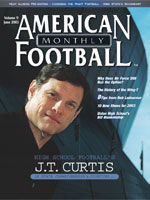Why Five is Better Than Four
©
More from this issue
Death.
Taxes. Four-panel footballs. In life and football, certain things are a
given, right? Guess again.
With the introduction this spring of its patented, five-panel VR5 series football,
Rawlings Sporting Goods not only continues to evolve football performance but
the football itself.
The concept for the ball comes from Jay Spiegel, a patent, trademark lawyer and
inventor, whose passion for kicking began in high school more than 30 years ago.
After studying engineering at Cornell University, where he was second-string
varsity kicker, Spiegel played several years of semi-pro football in the Washington,
D.C. area before turning what he calls a “grounding in the kicking game” into
a more product oriented approach. His first football-related invention, the Ground
Zero football kicking tee, is now used by every kicker in the National Football
League, and by many colleges and high schools.
With traditional football specifications in mind, Spiegel turned his attention
to the football itself in the mid to late 1990s. “I wondered if one could
try to forget about all those requirements and see what could be done to create
a football that might be enhanced for the kicking game,” Spiegel said.
As Spiegel points out, on a traditional football, the laces create a weight imbalance,
not to mention the worst of all possible kicking surfaces. But when the football
is spun so the laces face the goal post, the kicker is left with another, equally
irregular surface - a seam. Now as any kicker can tell you, kicking the ball
on a seam, the place where both moisture and mud readily accumulate, does little
for accuracy, not to mention control.
“It occurred to me at that time that if the football had an odd number
of panels then when one kicks opposite the laces one would be kicking in the
middle of a panel,” Spiegel said. “And, that would be a much more
regular and consistent, less slippery surface to kick.”
Thus, removing, or perhaps more accurately, relocating the seam opposite the
laces became Spiegel’s goal. Doing so would require an odd number of panels.
But how many? Three? Five? Seven? Nine? Eleven?
Spiegel’s research took him to the Professional Football Hall of Fame in
Canton, Ohio. What he learned there was that his attempt would be the first to
make an odd-panel football. But in order for his concept football to succeed,
it would have to first meet traditional football specifications and then change
the rules of the game.
“There comes a time, with too many panels, when you can’t maintain
the integrity of the football, in other words the thickness of the panels,” Spiegel
says, “and still maintain oneself within the weight requirements, which
is a minimum of 14 ounces and a maximum of 15 ounces.”
According to Spiegel, the Rawlings’ VR5 model, aside from the extra panel,
has no other physical differences and weighs in on the lighter end of this scale,
under 14.5 ounces. But, if all that Spiegel and Rawlings had created was a lightweight
ball with a “sweet spot” for kicking, the VR5 would have short-lived
success.
Interestingly enough, that’s where the ball’s extra panel seems to
play its biggest role. According to Spiegel, in field testing, quarterbacks,
especially those with smaller hands, found the ball easier to grip. The ball
itself is not smaller, but with the positioning of the second seam closer to
the laces, some quarterbacks were able to use this seam to get a better grip
on the football. The result? Better control and accuracy. Not to mention the
potential for more competitiveness, Spiegel says.
“The real advantage of this ball is that quarterbacks with smaller hands
can grab that second seam past the laces and gain control that they wouldn’t
otherwise have,” Spiegel said. “Therefore even if they don’t
have the velocity or the distance of a larger more physically developed quarterback,
they can still compete with that quarterback because of accuracy. And for quarterbacks
who have power in their arms and can grab that second seam as well, it really
can enhance their game.”
According to Spiegel, this notion of increasing competitiveness helped the five-panel
football break the rules. In 2001, the National Federation of State High School
Associations (NFHS) approved the first rule change for ball specifications since
1934, eliminating the requirement that the football have four panels. Spiegel
remains confident that similar NCAA approval is imminent.
“This ball can allow quarterbacks of disparate physical abilities to compete
with one another on a more equal plane, and the change is not visible to the
average fan sitting in the stands,” Spiegel said. “It’s not
like artificial turf or a change from a leather helmet to a plastic helmet. All
those changes are very visible. This change is invisible, but yet it makes games
more competitive, potentially.”
continue with...
Getting Footballs Game Ready





